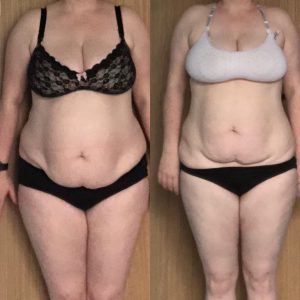What a difference 4 month’s make when the most effective and appropriate exercises are prescribed for a lady 7 month’s postnatal. These photos were taken 4 months apart. The results speak for themselves.
It’s not easy finding time for yourself with a baby, one is often sleep deprived, energy deficient and without the drive to exercise. My client ‘Y’ provides the proof that just 15 minutes of prescribed postnatal exercise every day can positively change and sculpt your body post birth.
We certainly aren’t talking about high impact exercises but slow and controlled, rhythmic movements using resistance/mini bands, soft Pilates balls and hoops. To begin my attention is focused upon strengthening the abdominal muscles from the inside out. Building a strong foundation upon which functional exercises can be layered without setbacks further down the line. Progressions are slow but that’s the point. Get this wrong in the early stages of postnatal recovery and your setting yourself up for future pelvic floor/core/lower back issues which can’t be ignored or brushed under the carpet as symptoms will worsen over time.
So, what have I done to help?
By combining the synergistic relationships between pelvic position, the breath and imagery I teach clients to correctly engage their pelvic floor both consciously and unconsciously and strengthen their deepest abdominal muscles. It is no longer or simply about ‘vaginal squeezing’ or ‘sucking in your tummy’!
Once core tension has improved integrated ‘functional’ exercises can be introduced known as the ‘Motherhood Movement Patterns’. These include the;
- Squat
- Lunge
- Push
- Pull
- Bend to extend
- Rotate
- Balance
The term ‘functional’ exercise has recently become a buzz word in the fitness industry. For the postnatal client this means exercise prescription that helps one to perform ‘Activities of Daily Life’ (ADL) as she recovers from birth.
When one consciously combines and integrates the components of the ‘core’ including respiration we move to the land of integrated functional movement and HEY PRESTO you drop the pounds, get fitter, stronger and leaner just like client Y!
Key mummy ADL’s include walking and pushing the pram of which the functional exercise choice equivalent would be single leg work, lunge and horizontal pushing. Secondly, wiping small children’s noses = bend-to-extend, and finally picking up toys from the floor whilst hoovering = squat, bend-to-extend, push and pull. The stronger you become the easier it is to carry out these ADL’s whilst consciously being mindful of core activation and engagement on the exhale so not to weaken or create excessive intra-abdominal pressure leading to what’s referred to as the ‘mummy tummy’ or ‘postnatal pooch’.
Ladies if you want to start exercising post birth but have concerns about pelvic floor dysfunction, a weak core, diastasis recti (abdominal muscle separation) or even prolapse please, please, please avoid traditional exercises and high intensity fitness classes but come and see me for a private consultation.
